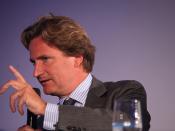What we see as Romance, is not really Romance at all. Words are sweet and wonderful, but do they really mean what they sound like? In "Madame Bovary," by Gustave Flaubert, the author uses equine imagery to satirize Romanticism, cleverly using horses to foreshadow the downfall of his carefully structured "Cinderella" scene. Madame Bovary will eventually die in large debt, and as Flaubert explicitly describes her gruesome death, our traditional ideas of Romance are knocked down. Charles is so distraught and filled with fury that his "nostrils fluttered, [and] his lips quivered" (Page 1249), just like a horse does when it gets agitated. All Rodolphe cared about was "farming, livestock, fertilizers"(1248). Charles contained everything that Emma wanted, yet she failed to see. By using this image of a horse in distress, Flaubert shows us Charles's true enraged emotion and his willingness to do anything to have her love him equally.
Unfortunately for Charles, Madame Bovary was in love with the man who did not care, and only saw her as an extra horse in his stable.
In Part One, Charles is a young man, sad and pathetic. His mom dresses him as a clown. "The newcomer wore heavy shoes, hobnailed and badly shined" (1037). Charles wears these heavy, hobnailed shoes just like a horse would, for the rest of his life. Flaubert uses this to foreshadow Charles's position in society, showing that he would never escape his poor caste and would be tightly nailed to a weight who would be Emma, bringing him down with her dreams of a man with nicer boots.
With his "headgear of composite order" (1038) on his lap, the teacher commanded Charles to shout his name amidst a torrent of jeers and laughs. With the exclamation, "Say it again!" (1038), Charles muttered his...


![[The Voisin brothers, French aviation pioneers. Gabriel Voisin (1880-1973), on the left, and Charles Voisin (1882-1912), on the right] (LOC)](https://s.writework.com/uploads/5/50179/voisin-brothers-french-aviation-pioneers-gabriel-voisin-188-thumb.jpg)